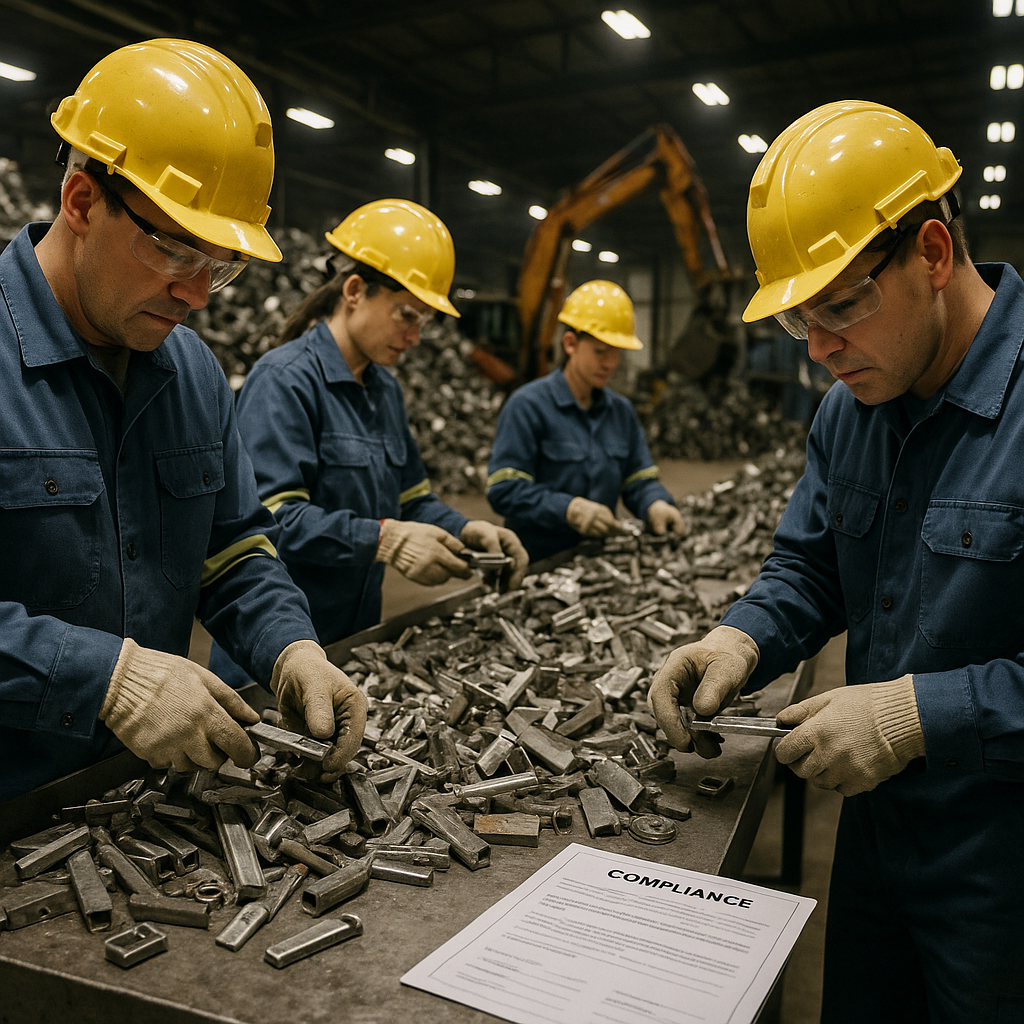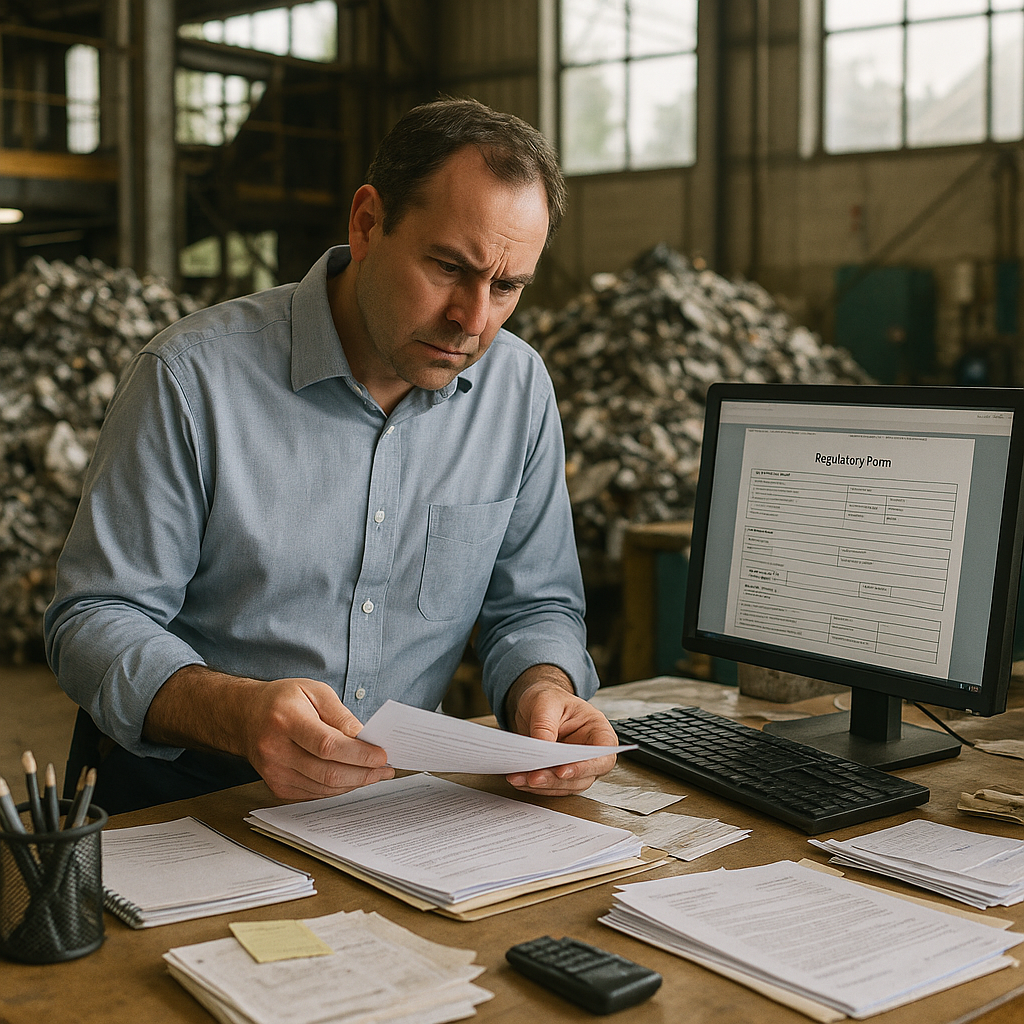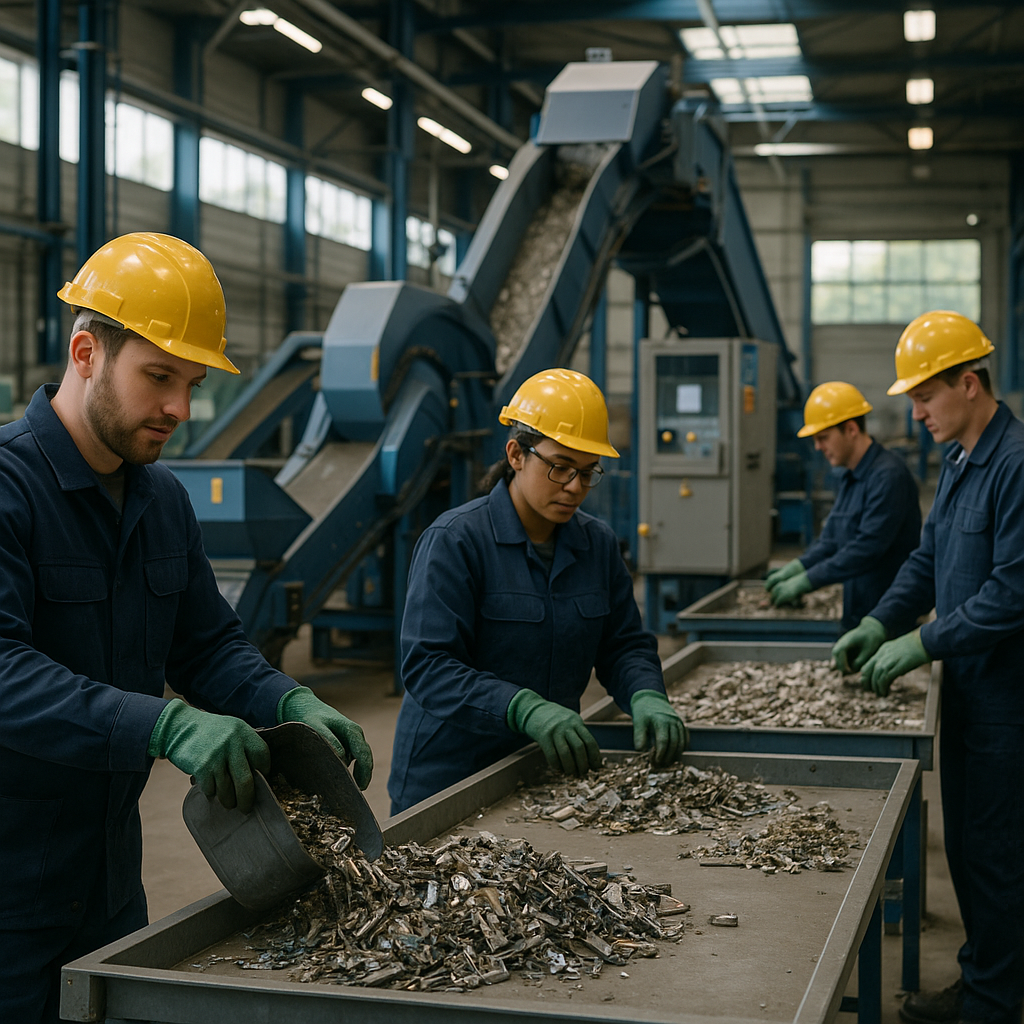5901 Botham Jean Blvd, Dallas, TX 75215
Everything You Need to Know About REACH Compliance in Metal Recycling
October 21, 2025REACH, which stands for Registration, Evaluation, Authorization, and Restriction of Chemicals, is one of the European Union’s most comprehensive regulatory frameworks. Introduced in 2007, this legislation underpins the EU’s approach to chemical safety and environmental protection.
In the metal recycling industry, REACH compliance is particularly important. The regulation applies to all chemical substances, including those in recovered metals and materials. For recyclers, this means adhering to specific requirements to ensure that recycled metals meet strict safety standards before returning to the market.
Metal recycling companies must identify and manage risks associated with chemicals in the materials they process. This involves documenting the presence of Substances of Very High Concern (SVHCs) and adhering to concentration limits. The ultimate goal is straightforward but crucial: to protect human health and the environment while supporting sustainable materials recovery.
How Does REACH Apply to the Metal Recycling Industry?

REACH regulation directly impacts the metal recycling industry as it applies to all chemical substances, including those in recycled metals. For metal recyclers operating in or exporting to the EU, compliance is not optional but a legal requirement that ensures both environmental protection and worker safety.
Metal recyclers face unique challenges under REACH. Recycled materials often contain various impurities or additives that weren’t initially documented, complicating substance identification. These unknown components may trigger registration requirements when present above specific thresholds.
Key REACH Requirements for Metal Recyclers
Metal recycling companies must navigate several critical compliance areas under REACH:
- Substance Registration: Recyclers must register substances manufactured or imported in quantities exceeding 1 tonne per year. This includes providing detailed safety information to the European Chemicals Agency (ECHA).
- Hazard Identification: Companies must evaluate the intrinsic properties of recycled materials and identify any substances of very high concern (SVHCs) that may be present.
- Risk Management: After identifying hazards, recyclers must implement appropriate risk management measures to ensure safe handling throughout the recycling process.
- Supply Chain Communication: Safety information must be communicated up and down the supply chain through safety data sheets and other documentation.
For recycled metals, the presence of alloys, coatings, and contaminants requires careful evaluation. Metals like lead, cadmium, or hexavalent chromium that are restricted under REACH may be present in recycled materials, necessitating special handling or processing.
Substance Identification Challenges
One of the biggest hurdles for metal recyclers is accurately identifying all substances in recycled materials. This is complicated by:
- Variation in input materials from different sources. Scrap metal may contain different alloys and trace elements depending on its origin and previous use. Some metals may have surface treatments or coatings with restricted substances. Recyclers must implement robust screening to identify problematic materials.
- Metal recyclers should establish testing protocols to determine the composition of incoming materials. This might include X-ray fluorescence (XRF) analysis or other analytical methods to identify potential substances of concern.
Practical Implementation Steps
To comply with REACH requirements, metal recyclers should follow these steps:
- Conduct a thorough inventory of all recycled metal streams and their potential chemical compositions
- Establish testing protocols to identify substances of concern in incoming materials
- Implement segregation procedures for materials containing restricted substances
- Develop clear documentation systems that track substances throughout the recycling process
- Train staff on proper handling of materials containing hazardous substances
- Stay updated on changes to the SVHC list and other REACH requirements
For smaller recycling operations, compliance costs can be significant, but industry associations often provide guidance and resources to help manage these requirements efficiently.
The European Recycling Industries’ Confederation (EuRIC) has developed sector-specific guidance documents that help metal recyclers understand their obligations under REACH.
Exemptions and Special Provisions
There is some relief for metal recyclers under REACH. Article 2(7)(d) provides an exemption for recovered substances under certain conditions. To qualify, the substance must be the same as one already registered, and safety information must be available to the recycler.
This exemption can reduce the regulatory burden for recyclers handling common metals with well-documented properties. However, the recycler must still confirm the substance identity matches an existing registration and obtain the relevant safety information.
Metal recyclers should maintain documentation demonstrating how they meet the conditions for any claimed exemptions. This is crucial during regulatory inspections to ensure continued compliance.
What Are the Key Challenges in REACH Compliance for Metal Recyclers?

Metal recyclers operate in a challenging regulatory environment where REACH compliance presents unique hurdles. Variability in the composition of recycled materials is one major challenge. Unlike manufacturers using virgin materials, recyclers handle metal streams that might contain unexpected substances, complicating consistent compliance.
This material variability results in significant testing burdens. Every batch of recycled metal may require extensive analysis to identify potential Substances of Very High Concern (SVHCs). This testing process is not only technically challenging but also adds substantial operational costs, which were not factored into traditional recycling business models.
Documentation and Administrative Burden
The administrative demands of REACH create a significant paperwork burden for metal recyclers. Companies must maintain detailed records of material composition, testing procedures, and supply chain information. This documentation must be readily available for inspection and often requires dedicated personnel to manage.
Small and medium-sized recycling operations face particular challenges in meeting these administrative demands. With limited staff and resources, keeping up with documentation can overwhelm operations that previously focused primarily on collection and processing.
The financial impact of these requirements can be substantial. Recyclers must allocate budget for testing equipment, staff training, and possibly external consultants to navigate the complex regulatory landscape.
Staying Current with Evolving Regulations
REACH regulations continually evolve. The European Chemicals Agency regularly updates the SVHCs list and modifies requirements. Recent updates to the Classification, Labelling, and Packaging (CLP) regulation from December 2024 highlight these challenges, introducing new hazard classifications and reporting obligations.
Metal recyclers must consistently monitor these changes and adapt their compliance strategies. This requires an ongoing investment in regulatory knowledge that many smaller operations struggle to maintain.
Enforcement mechanisms add another layer of pressure. Non-compliance can result in significant penalties, with fines reaching €30,000 for administrative violations and up to €5,000,000 for serious offenses impacting health.
Economic Viability Concerns
Balancing regulatory compliance with economic sustainability is perhaps the most pressing challenge. Recyclers operate on thin margins, and the additional costs of REACH compliance can threaten business viability. Testing, documentation, and staying current with regulations all represent new cost centers in an industry traditionally focused on volume and efficiency.
Market fluctuations compound these challenges. When metal prices drop, the additional compliance costs become even more burdensome, potentially making some recycling operations economically unfeasible during market downturns.
Smaller recycling businesses face disproportionate impacts. Without economies of scale, the per-ton cost of compliance is higher for small operations, which may drive industry consolidation.
Solutions and Best Practices
Forward-thinking recyclers are implementing strategies to address these challenges. Industry associations are developing shared resources and knowledge bases to help members stay current with regulations. Some recyclers are investing in advanced sorting and testing technologies to more efficiently identify potential SVHCs.
Collaboration across the supply chain has proven effective. By working closely with suppliers and customers, recyclers can develop better information-sharing systems that reduce the documentation burden while improving compliance.
Digital tools are increasingly important for managing the administrative aspects of REACH compliance. Software platforms specifically designed for recyclers can streamline documentation requirements and provide alerts about regulatory changes.
For smaller operations, seeking external expertise through consultants or partnerships with larger companies can provide access to compliance knowledge without maintaining full-time regulatory staff.
What Are the Benefits of REACH Compliance in Metal Recycling?

Adhering to REACH compliance offers significant advantages for metal recycling operations beyond simply meeting regulatory requirements. Companies that embrace these standards enhance their operational performance while supporting broader environmental objectives. Here are the primary benefits of REACH compliance for metal recyclers.
Enhanced Workplace and Public Safety
REACH regulations directly improve safety conditions throughout the metal recycling process. By limiting hazardous substances like hexavalent chromium and lead, REACH creates safer working environments for employees handling scrap materials. This results in fewer workplace incidents, reduced exposure to carcinogens, and lower long-term health risks.
The safety benefits extend beyond facility walls. When metal recyclers eliminate or manage substances of very high concern (SVHCs), they protect surrounding communities from potential contamination through air, water, or soil. This approach demonstrates corporate responsibility while reducing potential liabilities.
Significant Environmental Protection
Metal recycling already provides substantial environmental benefits through resource conservation. REACH compliance enhances these benefits by minimizing ecological harm during recycling. The regulation’s focus on identifying and restricting persistent bioaccumulative toxins prevents harmful substances from re-entering ecosystems.
The environmental impact is measurable. For example, aluminum recycling with REACH compliance uses 95% less energy than producing new aluminum and reduces the risk of reintroducing restricted substances. Steel recycling similarly saves about 60% energy compared to virgin production while strictly controlling harmful chemicals.
| Benefit | REACH-Compliant Recycling | Non-Compliant Operations |
|---|---|---|
| Energy Efficiency | Aluminum recycling uses 95% less energy; steel saves 60% energy compared to virgin production | Higher energy consumption due to primary production methods |
| Greenhouse Gas Emissions | Reduces CO2 emissions: Aluminum recycling avoids 9 tons per ton; steel reduces by 2 tons | Higher carbon emissions due to extraction and smelting processes |
| Pollution | 86% reduction in air and 76% reduction in water pollution | Extensive air and water pollution from mining and refining |
| Waste Management | Reduces landfill waste and prevents toxic leaching | Increased landfill usage and potential for soil and water contamination |
| Worker and Community Safety | Minimized exposure to hazardous substances due to strict regulations | Higher risk of exposure to hazardous substances |
| Market Access | Enables access to EU market with regulatory compliance | Restricted market access due to non-compliance |
Expanded Market Access and Business Opportunities
The most compelling business case for REACH compliance is market access. The European Union strictly enforces these regulations, requiring compliance from any recycler selling materials to EU manufacturers. As more regions adopt similar standards, REACH compliance becomes essential for global market access.
This market advantage extends throughout the supply chain. Manufacturers increasingly specify REACH compliance when purchasing recycled materials. Companies that consistently comply gain preferred supplier status, securing stable business relationships and potentially commanding premium pricing.
Strengthened Customer and Regulatory Trust
REACH compliance builds credibility with customers and regulatory authorities. The detailed documentation requirements create transparency about material composition and handling practices, directly translating into trust—a valuable asset in an industry often scrutinized for environmental practices.
Regulatory authorities recognize compliant companies as responsible operators. This recognition can streamline interactions with government agencies, potentially reducing the frequency and intensity of inspections or audits. Many recyclers report smoother permitting processes when they can demonstrate comprehensive REACH compliance systems.
Competitive Differentiation in the Marketplace
Forward-thinking recyclers leverage REACH compliance as a competitive advantage. By investing in the necessary systems and training, these companies position themselves as premium partners rather than commodity suppliers. This differentiation becomes increasingly valuable as sustainability concerns influence purchasing decisions throughout the supply chain.
The competitive benefits compound over time. Companies with established REACH compliance systems adapt more quickly to regulatory changes than competitors playing catch-up. This adaptability represents a strategic advantage in a regulatory environment that continues to evolve toward stricter controls on hazardous substances.
Operational Improvements and Efficiency Gains
Many recyclers discover that achieving REACH compliance drives operational improvements. The detailed material assessment required by REACH often reveals opportunities to streamline sorting processes, improve quality control, and enhance material recovery rates. These efficiency gains can offset compliance costs while improving overall operational performance.
The systematic approach required for REACH compliance frequently leads to better documentation and tracking systems. These improved systems enhance inventory management, facilitate quality assurance, and provide valuable data for business optimization. What begins as a regulatory requirement often evolves into a business improvement initiative with lasting benefits.
Conclusion: The Future of REACH Compliance in Metal Recycling

The landscape of REACH compliance for metal recyclers is evolving rapidly. With the European Commission expected to propose a targeted revision of EU REACH Regulation by Q4 2025, metal recycling operations must prepare for new obligations. This revision is likely to streamline regulatory processes while expanding requirements, particularly around hazardous substance management. For metal recyclers, staying ahead of these changes ensures not only avoiding penalties but also securing long-term market access in the European Union.
Industry collaboration will be essential as these regulations develop. In sectors like aluminum and zinc, sharing knowledge about compliance strategies and best practices has significantly reduced the burden on individual companies. The metal recycling industry has an opportunity to unite in developing standardized approaches to chemical management, testing protocols, and documentation systems that satisfy regulatory requirements while maintaining operational efficiency. This collaborative effort will be especially valuable for smaller operations with limited compliance resources.
For your recycling compliance needs, contact Okon Recycling at 214-717-4083. Our team can help you navigate the complexities of REACH requirements and develop a sustainable compliance strategy for your metal recycling operations.
